How to Align Distributed Content Teams Around a Shared Strategy
Working across time zones shouldn’t mean missed deadlines and mixed messages. At Relato, we’ve talked to content leaders who’ve figured out how to keep remote teams aligned without constant check-ins. This article breaks down the systems, habits, and tools they use to make collaboration actually work.

You’ve got in-house marketers in one time zone, freelancers in another, and an agency partner juggling three other clients — all working together to ship one campaign. The strategy is clear and the team is skilled, but execution often falls apart.
Strategy lives in a doc no one opens after kickoff. Tasks live somewhere else entirely. And people start working toward different goals, losing sight of what Kasey Steinbrinck, Senior Content Marketing Manager at Mailgun by Sinch, calls the real "North Star."
“People get focused on meeting deliverables or specific KPIs and forget the big picture.” “If doing what's right for the customer and the target audience isn't everyone's North Star, then you're missing the point.”
The State of (Dis)Content even highlights how 43% of content marketers struggle to align content efforts across teams. So, how do content teams keep strategy and execution connected even across distributed setups?
We asked Kasey and other experts, including:
- Leah Alves, SEO Manager at Qwilr
- Kaitlin Milliken, Senior Program Manager at HubSpot
- Sean Collins, SEO Content Manager at Scoro
- Janine Anderson, Content Operations Manager at Zapier
- Tom Shapiro, CEO of Stratabeat
- Hailley Griffis, Head of Communications and Content at Buffer
Here’s what they suggest.
Why strategy often breaks down across distributed teams
Strategy may look solid at kickoff, but it quickly wobbles as teams return to their corners: misaligned deliverables, inconsistent messaging, and conflicting priorities.
This tunnel vision happens for a few key reasons:
Documentation without context disappears into the void. That beautiful strategy deck in Google Drive? Without links to daily work, it’s just something everyone nodded at once, then forgot.
Casual reinforcement conversations don't happen. Distributed teams miss the quick check-ins, coffee chats, and "hey, quick question" moments that naturally keep everyone aligned in an office.
Top-down processes kill diverse perspectives. Leah learned this firsthand while managing her distributed content team:
"I initially did these very in-depth content briefs that really didn't include a lot of room for writers to include their own research, creativity, or ideas. Because the briefs were too rigid and all coming from one person, we ended up with cookie-cutter articles."
Top-down strategy kills distributed teams’ biggest strength: fresh ideas from remote teammates, freelancers, and agency partners. Teams focus on hitting deadlines and word counts instead of creating content that serves the audience.
Create a single source of truth
A single source of truth brings all your content standards, workflows, and assets into one place so your team always works from the same page.
This could be a shared Google Drive, a Notion or Trello board, or a pinned Slack channel — as long as it’s accessible and regularly updated.
For HubSpot, this single source of truth takes the form of a simple email system combined with Asana. Kaitlin explains their approach to keeping their distributed writing team aligned:
"We send each writer one email with every link they need: the original article, Asana card, instructions, and a group Google Doc (for refreshes)."
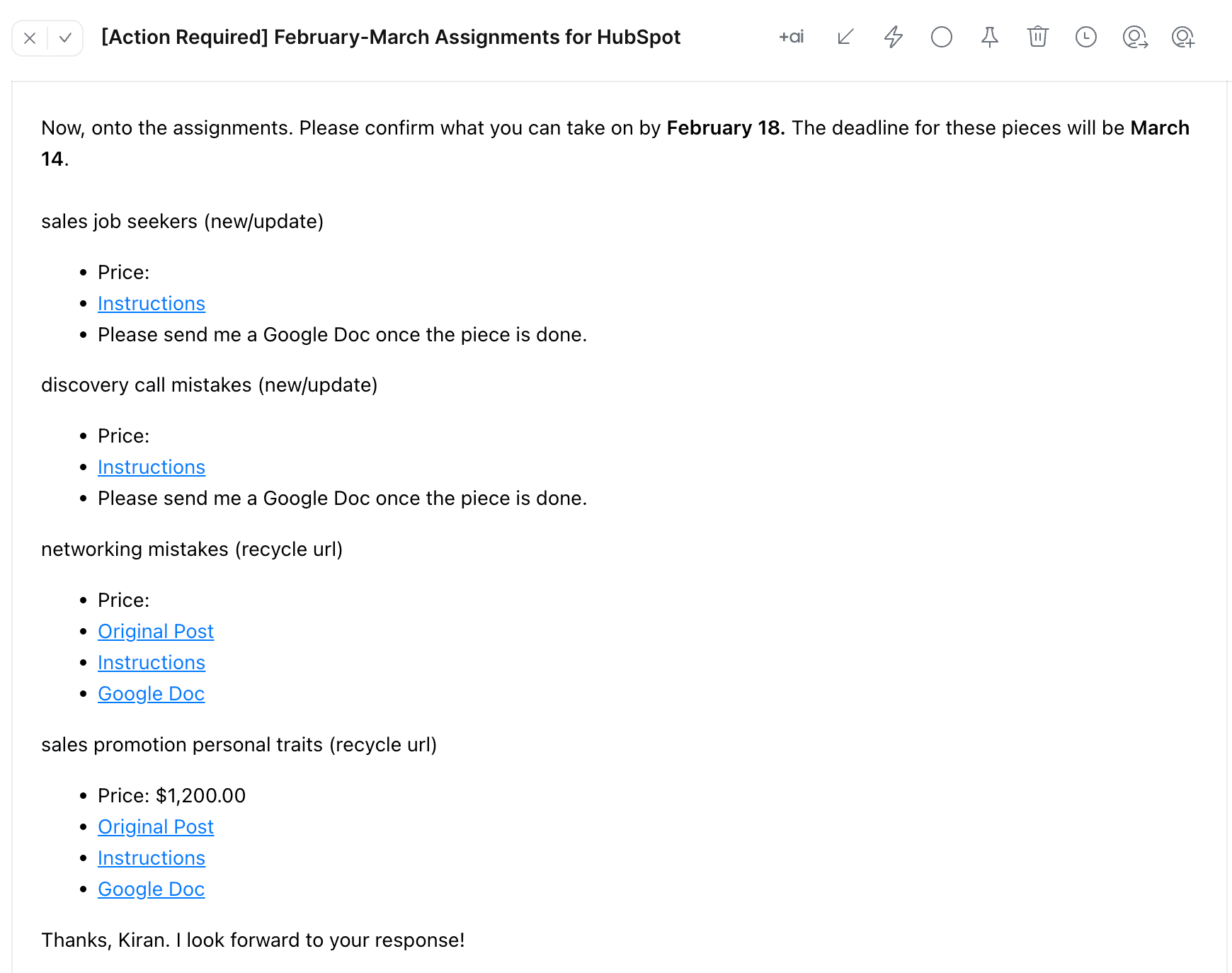
This workaround creates a single entry point even when using multiple tools.
You can also consolidate everything your content team needs into one workspace with Relato (and avoid the Frankenstack).
The dashboard, for example, gives you a bird’s eye view of project status across all workspaces, team workload distribution, and individual contributor capacity.
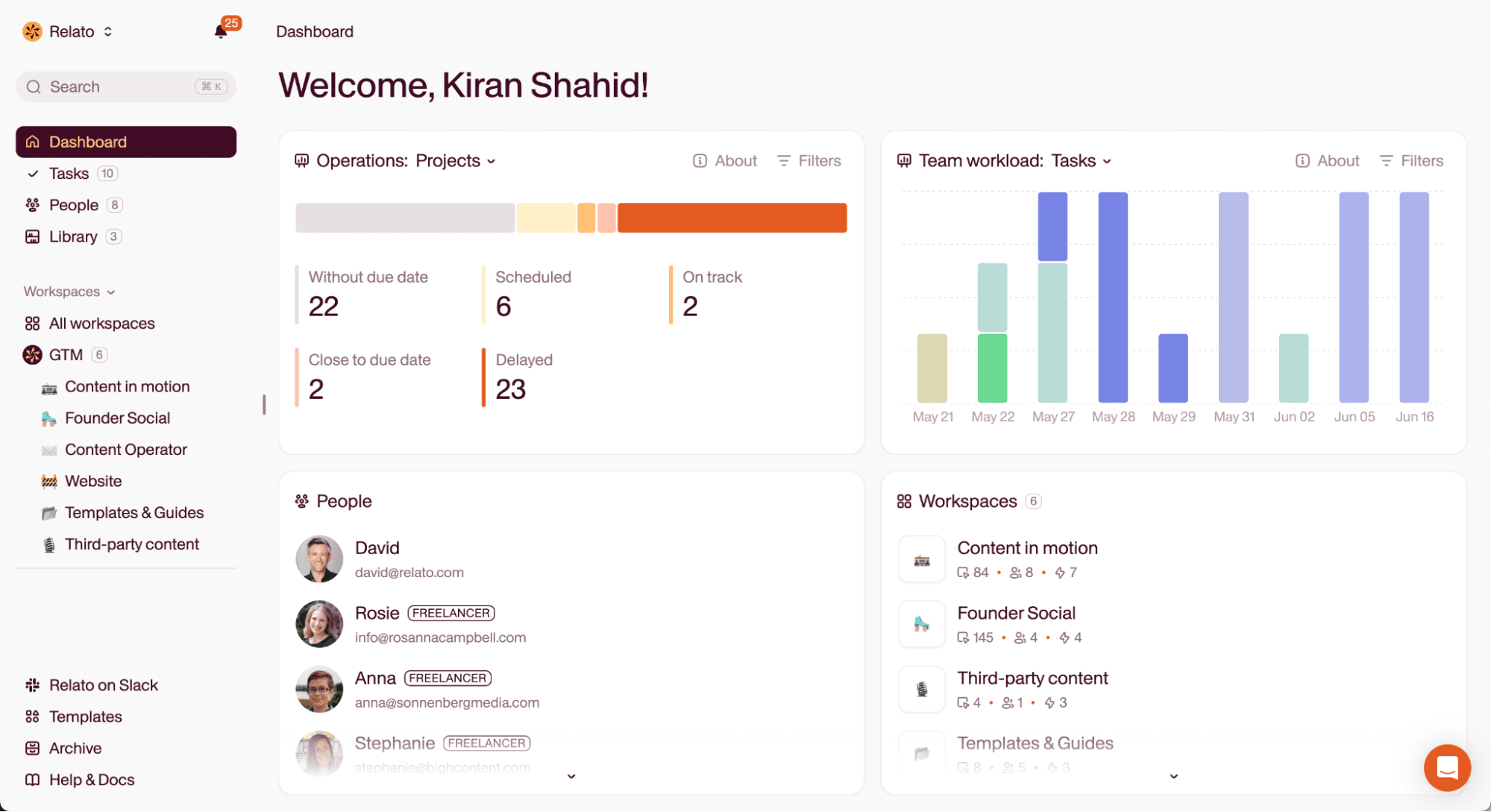
See what's on track, delayed, or bottlenecked without switching tools or requesting updates.
Relato’s Library is your central asset hub with briefs, content, interviews, and filterable labels to keep everything organized.
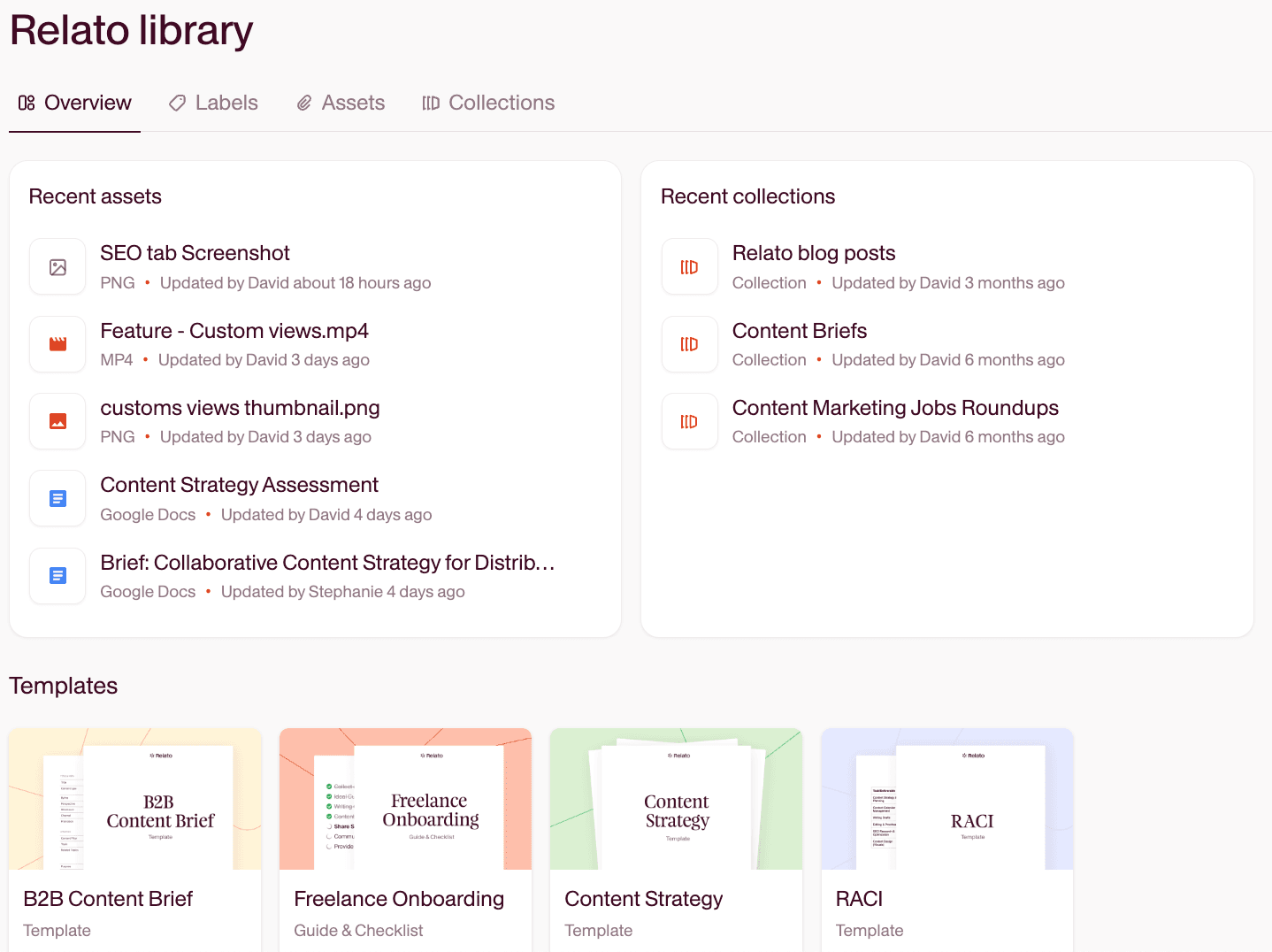
Instead of hunting across Google Drives, Slack channels, and various wikis, you can host all these essential documents in one searchable location:
- Strategy docs like audience personas, editorial calendar, KPIs
- Brand guidelines like voice/tone guide, writing dos and don'ts
- Content briefs
- Product info like feature descriptions, product screenshots
- Technical guidelines like SEO best practices, formatting rules
- Audience personas
Note: See what you have before creating duplicate resources. Sean uses the knowledge base for getting their content team up to speed: "Honestly, one of our best tools is our own Help Center. The articles are detailed and written clearly enough that content creators — internal or freelance — can get up to speed fast without needing constant input from product teams."
Once you create your hub, maintain it actively. "If there's a really important product or process update, I'll contact writers directly with the supporting documentation," says Leah. Regular updates prevent duplicated work, missed deadlines, and version confusion.
“If there's a really important product or process update, I'll contact writers directly with the supporting documentation.”
When everyone can easily find what they need without gatekeepers or bottlenecks, work flows more smoothly, and content quality naturally improves.
Streamline communication to reduce overload
Clear expectations on info, requirements, and feedback timelines eliminate constant check-ins.
Grammarly’s 2024 State of Business Communication report highlights how effective and poor communication have ripple effects across your team:

Here’s how to set up a system that keeps communication lean and useful:
Keep communication simple and purposeful
Communication can easily become a source of friction instead of clarity. Strategic decisions get buried, quick questions become 30-minute meetings, and team members waste time chasing updates.
The fix isn’t “more communication” — it’s using the right format for the right kind of message.
Kasey uses a flipped meeting approach to make the most of limited overlap across time zones:
“One of the things I've found challenging in a distributed team across time zones is finding time to collaborate remotely. Instead, it's more effective to send a recorded presentation in advance. That way, when we meet, we can use the time for Q&A and brainstorming — you might even end early.”
“One of the things I've found challenging in a distributed team across time zones is finding time to collaborate remotely. Instead, it's more effective to send a recorded presentation in advance. ”
This shift frees up meetings for high-value collaboration and cuts passive listening. Editors can apply the same principle with quick Loom walkthroughs for content feedback and give writers clarity without needing to hop on a call.
Leah takes a similar approach when it comes to async learning. She stopped running live SEO workshops and replaced them with a self-serve doc that writers could revisit as needed. As a result, live meetings were reserved for discussion while documentation alone worked for reference.
Tom also keeps daily communication structured and purposeful with a two-tier system:
“We manage communications in a centralized online project management platform (previously Basecamp and now ClickUp). For quick conversations and check-ins, we use Slack.”
That separation — structured work in one place, real-time nudges in another — cuts back on endless notifications and helps everyone find what they need, fast.
Zapier takes this further with automated distribution for their high-volume operation. "We publish more than 100 blog posts a month, some of which are really important for other teams to know about," explains Janine.
“We use a Zap that posts every new blog article to a Slack channel via the RSS feed. For more targeted internal distribution, we also have scheduled Zaps that post blog digests in relevant Slack channels, like one for partner managers that highlights articles about key apps on the Zapier platform.
“This reduces questions from teams about relevant new content and saves them from having to hunt for updates.”
Strong communication across teams needs clear channels, clear goals, and automation. When you're producing a lot of content, manually sharing it slows everything down. Set up systems that automatically update the right people so your team can focus on creating, not coordinating.
Be rigid on deadlines, flexible on execution
Deadlines keep async workflows from stalling. Kaitlin works with a large pool of freelancers and emphasizes fixed timelines to reduce confusion and keep work moving.
“A lot of these changes are happening async for our freelance writers because we have folks all over the world, so we just kind of build in set deadlines, and we give people a week to make revisions if we have to send a piece back.”
Fixed timelines reduce back-and-forth and let writers work in their time zones. But not every team requires this structure.
When working with a small pool of trusted writers or creating thought leadership pieces that require deeper research, writers can set their own deadlines based on their bandwidth and creative process. Decide based on your content goals.
Set boundaries around feedback and reviews
Content reviews derail timelines when stakeholders delay or request endless changes.
Kasey offers practical advice for keeping the review process from becoming a bottleneck:
"The best advice is simple: limit the number of people involved in the content review process as best you can. Then, give very clear deadlines and build a little margin into the review process to make room for last-minute requests."
The more cooks in the kitchen, the slower (and messier) the content gets. Keep it lean with clearly assigned roles.
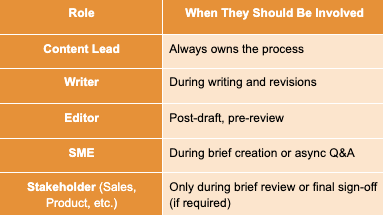
Limiting reviewers to three to four people and setting response deadlines creates a feedback system that delivers decisions quickly rather than endless revision cycles.
Build systems that support distributed teams
You need clear systems to assign work, track progress, and minimize back-and-forth communication. These are the operational foundations that keep distributed teams efficient and aligned.
Onboard team members for long-term success
One of the most effective ways to improve content quality in a distributed team is to strengthen your onboarding process. Clear systems upfront reduce revisions later and help contributors deliver strong work from the start.
Sean built a simple one-pager that gives new writers everything they need to get up to speed.
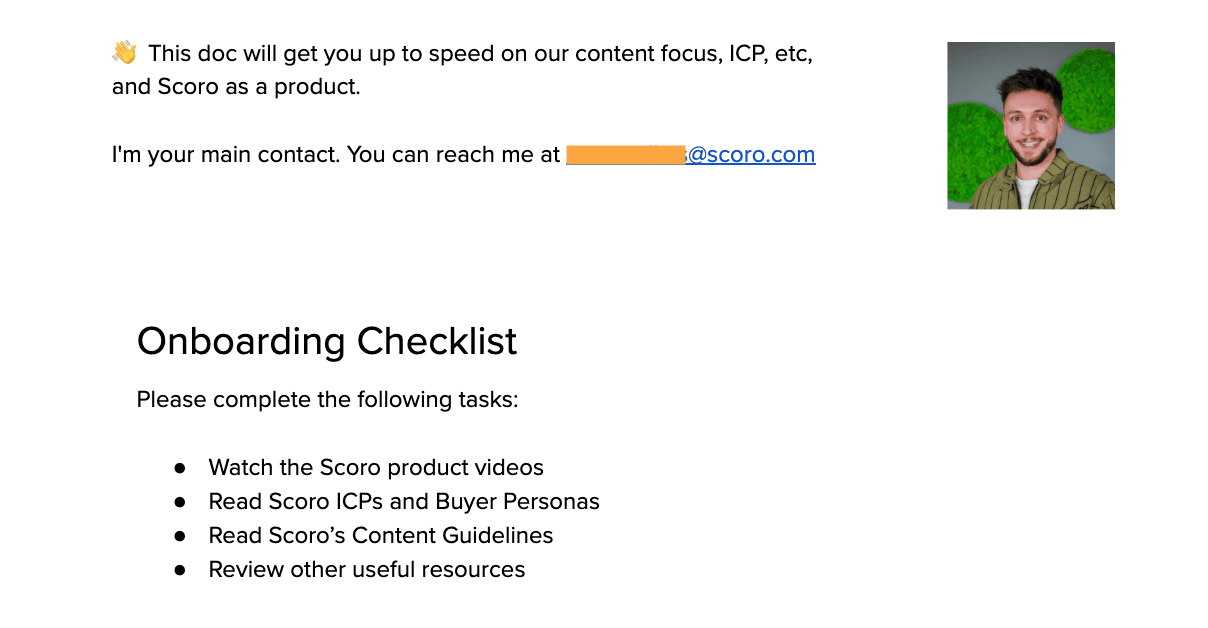
The one-pager includes:
- Intro + contact info: A quick welcome message and a note telling them he’s their main contact for any questions
- Onboarding checklist: Tasks like watching product demos, reviewing personas, and exploring the Help Center
- Product 101: A plain-language summary of what Scoro does and who it serves
- Content focus: Key content themes like profitability, operations, and resource planning
- Writing guidelines: A detailed blog guide covering tone, structure, and formatting
With clear expectations in place, writers ramp up faster and can work more independently, without needing constant check-ins or clarification.
Buffer takes a similarly thoughtful approach to onboarding, especially when it comes to helping contributors internalize their brand voice. Rather than relying solely on style guides, they treat the early editing process as a hands-on learning experience.
“For both new teammates and freelancers, we set clear expectations that editing will be heavier at the beginning to ensure the voice and tone matches what we write for the Buffer audience,” says Hailley Griffis, Head of Communications and Content. “Rather than just correcting, we use these early edits as moments to get into the nuances of our brand voice.”
Of course, onboarding is even easier when you’ve taken the time to find strong writers in the first place. Leah pairs smart hiring with clear systems from day one.
“I opted to find incredible writers and onboard them in a way that really set them up for success by providing docs like an internal linking matrix.”
“I opted to find incredible writers and onboard them in a way that really set them up for success by providing docs like an internal linking matrix.
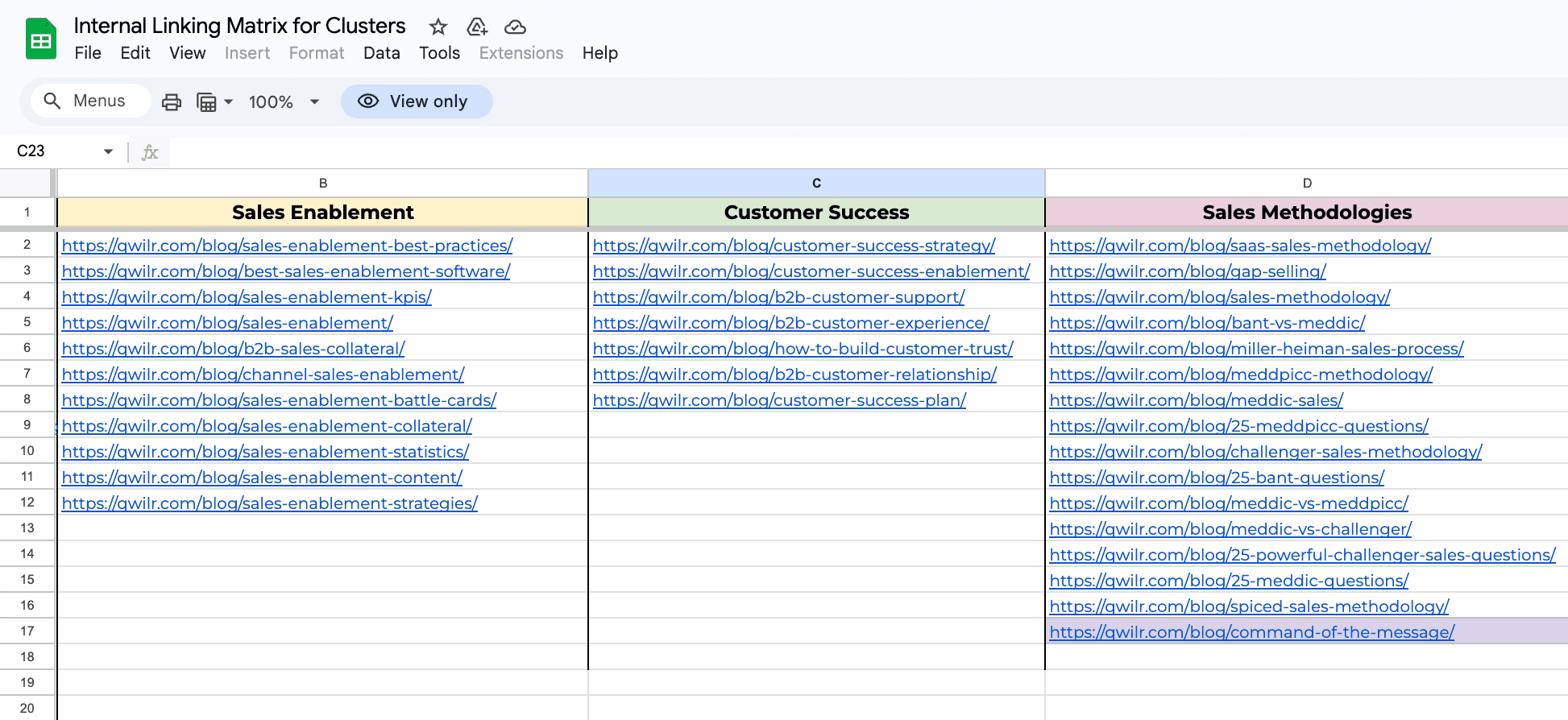
I also have a checklist I use for optimizing pages during SEO updates, and I baked that into our onboarding so writers can create fully optimized pieces from the start, instead of us fixing things later.”
Smart hiring, plus structured onboarding, builds trust and reduces future revisions.
Leave room for creativity
Find the sweet spot between strategic direction and creative freedom to allow contributors to bring their unique perspectives while maintaining brand consistency.
Kaitlin and Tom both set broad parameters while giving writers room to make content their own.
For example, HubSpot gives writers "broad instructions like 'write the piece in first person or test a tool and tell us how it went.” But what that looks like is up to the writer's experience."
Tom also gets on brainstorming sessions with the team, treating them as structured creative exercises rather than free-for-alls, even when they’re remote.
“We love to brainstorm in small groups, and this works just as well over Zoom as it does in person.”
“We love to brainstorm in small groups, and this works just as well over Zoom as it does in person. Typically, we give the participants the specific topic ahead of time so everyone can start thinking of content ideas even before we get together.
Sometimes we'll use a shared matrix to help us evaluate the ideas, assessing each idea against the time required, effort, cost, anticipated results, and ROI. The matrix makes it very clear which ideas to pursue and which to save for another day.”
Here’s what that might look like:

Creative energy doesn’t have to suffer in remote settings, as long as the format encourages focused thinking and gives the team a straightforward way to evaluate what’s worth acting on.
Meanwhile, Leah stresses balancing creative freedom with tactical guidance:
"I still believe in having SOPs, especially granular ones. I used to assume writers knew what I meant with SEO or formatting terms, and it caused a lot of unnecessary back-and-forth."
These leaders apply the same principle: balance structure with flexibility. Here's how that varies across content types:
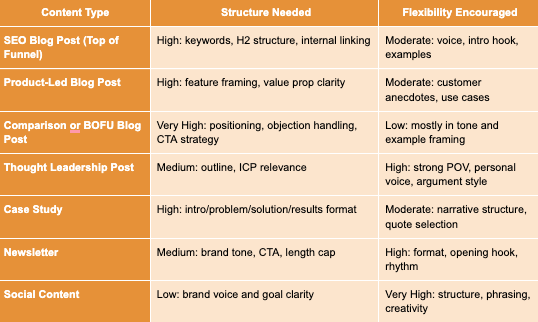
Prioritize what’s important for momentum and what requires deep thinking. As Hailley says, “Not every piece of content needs hours of contemplation, but for pivotal projects or strategy work, we deliberately create a space for deep thinking.”
Make work visible to reduce check-ins
When everyone can see where work stands, who’s involved, and what’s coming next, there’s less need for check-ins and more room for actual progress. Unlike general-purpose tools like Notion or Asana, Relato is built specifically for content teams.
The workspace view shows who’s tackling what in real time. You can toggle between Kanban, calendar, and table views, depending on how your team prefers to track progress.
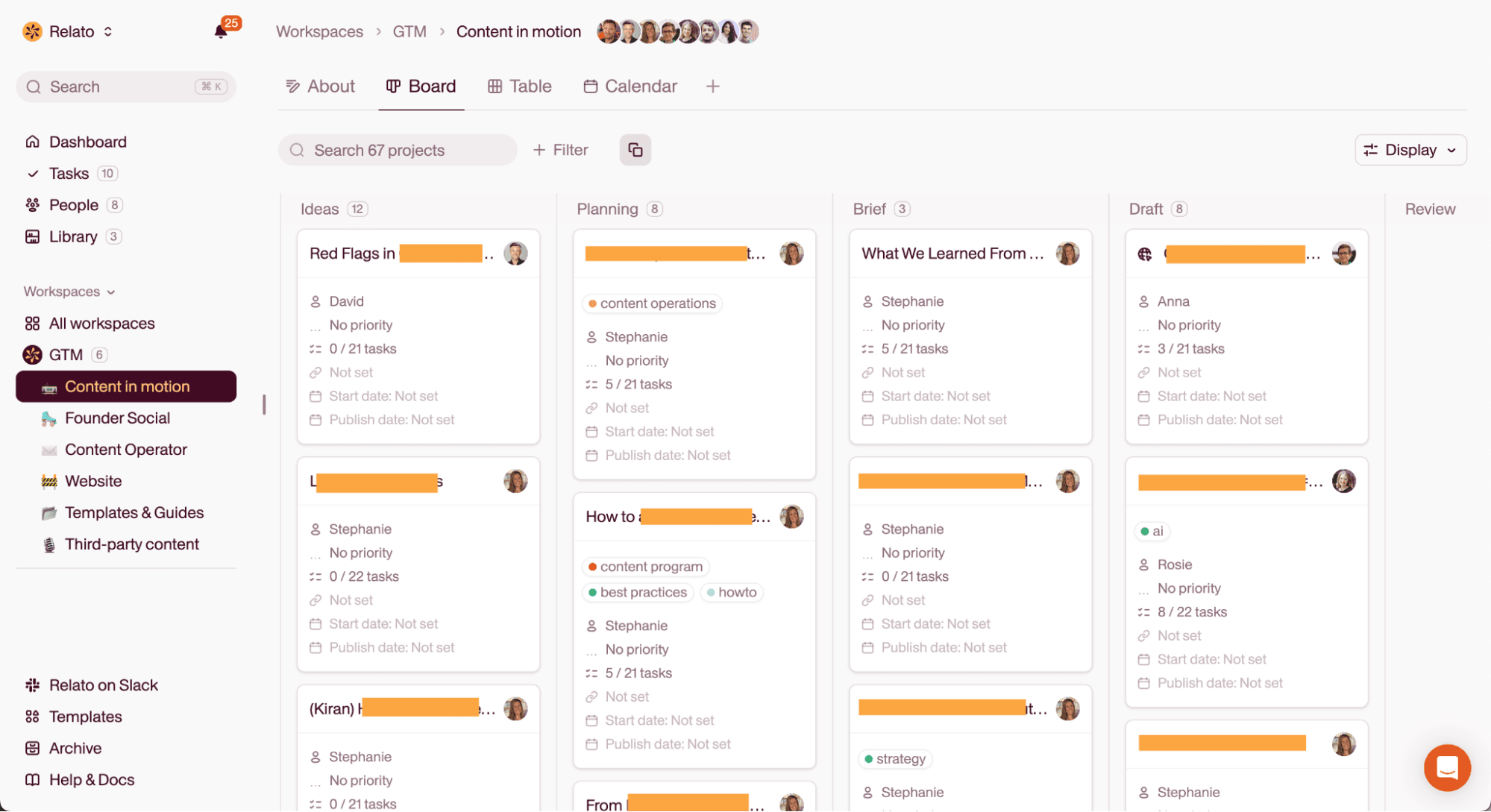
Whether it’s a pipeline or a content calendar, everything lives in one place.
Open a task card — like a blog post or case study — and view the steps, content team roles, and responsibilities clearly laid out.
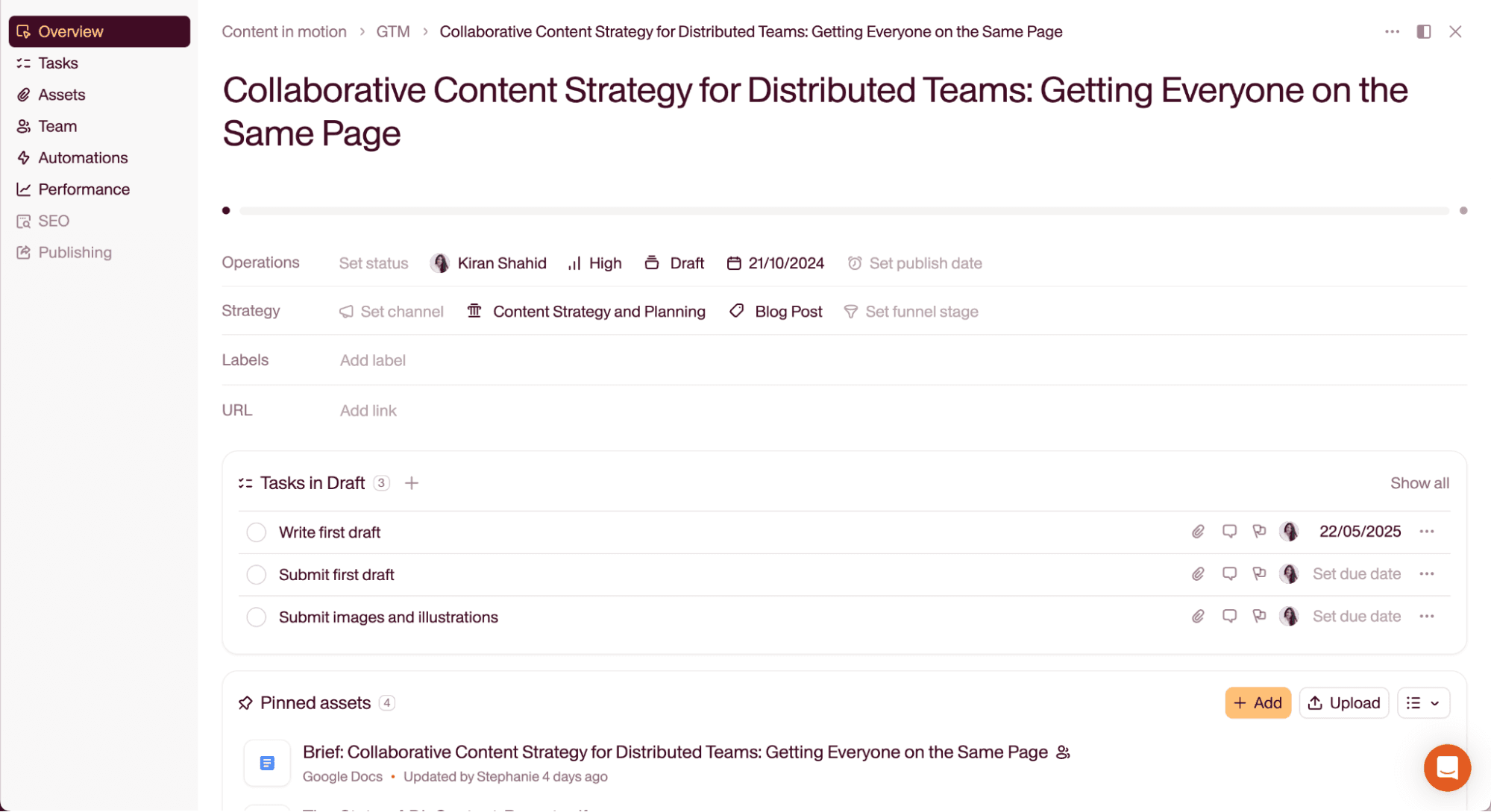
Each task clearly shows who’s responsible for what, along with assigned roles like writer, editor, or reviewer.

This makes it easy for everyone to understand where they fit and what’s expected.
Pro tip: When choosing tools, consider who needs access beyond your core team. The Zapier team prefers Airtable. As Janine says, “It's easy to give access to non-team members who need to observe our process but not change anything within it."
Relato takes this further with role-based access and customizable labels like “Freelancer” or “Agency Partner,” so you can control who sees what.

That means external collaborators get the visibility they need to stay aligned, without risking accidental edits or confusion.
Instead of forcing you to patch together docs, databases, and task lists, Relato gives you built-in workflows tailored for content teams, like role assignments and approval steps, to make it easy to get started.
Maintain alignment through culture and consistent touchpoints
Clear comms help with daily ops. But shared experiences and check-ins keep teams aligned on voice, consistency, and strategic impact.
A mix of building team culture and regular catch-ups turns a group of remote workers into a connected team with shared goals.
Build a remote-first culture that stays connected
Distributed teams thrive when they can move independently without losing alignment. That kind of autonomy only works when there’s a shared understanding of how the team communicates, documents decisions, and tracks work.
Buffer, remote from day one, built that foundation deliberately.
“Documentation has become our superpower at Buffer,” says Hailley. “We've developed a habit of writing everything down — strategy documents, meeting notes, and even decisions from Slack threads. This documentation culture has made our work more intentional and transparent, and I doubt we would have built such a strong practice in an office setting.”
“Our documentation culture has made our work more intentional and transparent, and I doubt we would have built such a strong practice in an office setting.”
Their async workflows reinforce that culture. On Buffer’s content team, passing drafts, giving feedback, and even brainstorming happen asynchronously by default.
“We’ve established clear expectations around response times for these reviews and brainstorming sessions, usually within 24 to 48 hours, depending on the urgency. For larger discussions that require deeper thinking, we intentionally move conversations out of Slack and into our internal long-form async tool.”
By building habits around clarity, responsiveness, and deep thinking, Buffer’s team avoids the extremes of distributed work: moving too slowly or rushing without context.
But documentation alone isn’t enough. Regular rituals keep strategy from drifting into the background.
Buffer uses a layered cadence to stay in sync across quarters, months, and weeks:
- A quarterly marketing-wide doc outlines company priorities and big initiatives
- Monthly check-ins help the content team reflect on metrics and share insights
- A weekly editorial meeting aligns the team on the upcoming calendar and surfaces strategy gaps
They reconnect individual work with team-wide goals and help people see how their efforts ladder up.
Apart from check-ins, team-building rituals also promote bonding outside the workspace.
Buffer's annual retreat gives their fully remote team rare face-to-face time. One ritual involves bringing food from home countries, which sparks stories and creates common ground.

After retreats, collaboration flows more naturally at Buffer. “People feel more confident jumping into feedback threads or offering ideas because they've built that real-life rapport and understanding of each other's communication styles.”
One recent example? The content team used the retreat to untangle several design-related questions that would potentially drag out over Slack.
“For content discussions, the retreat was especially valuable for working closely with our Marketing UX Designer to address a few brand and systems questions that would have taken weeks of back-and-forth communication remotely. Being in person also gave us the perfect opportunity to capture authentic video content with the team, which we made the most of this time.”
You don’t need to do everything at once. But a few intentional habits — written norms, consistent check-ins, space to connect — help everyone stay plugged into the bigger picture.
Define shared success metrics and close the feedback loop
With distributed teams, it’s critical to align on what “good” looks like.
Sean recommends defining success across two layers: leading indicators like rankings and traffic, and lagging metrics like conversions and Sales Accepted Leads (SALs). This dual approach keeps teams grounded in both short-term performance and long-term impact, making it easier to prioritize content and stay aligned regardless of location.
When everyone understands how success is measured, it becomes easier to prioritize the right content, make better decisions, and stay aligned, regardless of location or role.
Note: This principle extends to agency partnerships. Kasey emphasizes the importance of shared ownership when partnering with external teams: “If their goals mirror your goals, you’ll both be working toward the same thing. Agency partners need to become strategic partners — not just order takers.”
The best collaborations, whether internal or external, start with mutual clarity, shared context, and aligned incentives.
After setting success metrics, share monthly dashboards or post-launch summaries highlighting what content resonated, where traffic spiked, and which formats drove conversions. Even a quick “This got picked up in sales calls” gives contributors useful feedback.
Leah stresses the importance of getting feedback from writers, too, through a simple survey.
“Writers are often the best people to spot disconnects like a super small point of friction that’s easy to solve but creates a ton of backlog.”
“Writers are often the best people to spot disconnects like a super small point of friction that’s easy to solve but creates a ton of backlog.”
When feedback flows in both directions — not just down from strategy — the entire team grows together.
Deliver better content outcomes through stronger collaboration
When distributed teams share a clear strategy, know their roles, and have space to contribute creatively, the work gets better and so does the process. Deadlines stop slipping. Feedback loops get tighter. And your team starts spending more time creating and less time chasing clarity.
Relato gives you a foundational system to get those results: one workspace for everything content teams need to move fast, stay aligned, and ship work they’re proud of.
👉 Already creating great content? Relato helps you do it faster with less confusion.